The AlphaCool Eisbaer Aurora 360 AIO Cooler Review: Improving on Expandable CPU Cooling
by E. Fylladitakis on August 11, 2022 8:00 AM EST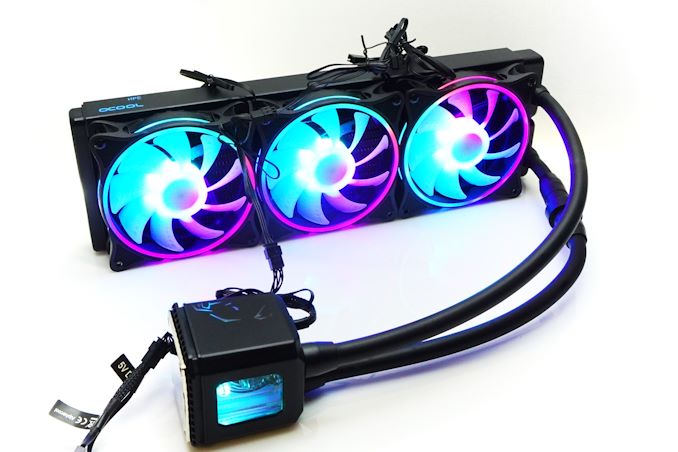
Many businesses devoted to the design and delivery of liquid cooling systems for PCs were established when the trend of liquid cooling emerged in the 1990’s. One of them was Alphacool, a German business that expanded their product lines to include liquid coolers for use in both industrial and medical applications. Using liquid-based cooling systems into a home PC faced very low adoption rates at the time. The complexity of liquid cooling, which necessitates considerable additional effort and user awareness, possibly was the largest drawback of most products available at the time.
Several years later, the first all-in-one (AIO) liquid cooling systems were released into the market. AIO liquid cooling systems were sealed and ready for installation, making them very attractive to people who sought a liquid-based cooler with an air-based cooler's installation convenience and relative safety. However, AIO solutions are relatively inflexible, and some hardly perform better than high end air-based solutions.
A few years ago, we had our first look at Alphacool’s Eisbaer AIO cooler, which was a hybrid between a sealed liquid cooler and a customizable open loop kit. Although the idea of a modular AIO cooler was new even back then, Alphacool’s Eisbaer was well made and performed very well, making it a rather popular product amongst advanced users and enthusiasts. In today’s review, we are taking a look at the new, upgraded version of the Eisbaer, the Eisbaer Aurora. The most noticeable upgrade is the inclusion of RGB lighting, but Alphacool also performed some quality and practicality upgrades over the previous version.
| Alphacool Eisbaer Aurora 360 AIO CPU Cooler Specifications | |||
| Type | All-In One (Expandable) | ||
| Rad Dimensions | 397 x 124 x 30 mm | ||
| Pump Dimensions | 66 x 66 x 69 mm | ||
| Fans | 3 x 120 mm "Eiswind" Fans 800 - 2000 RPM, 61.5 CFM |
||
| RGB | Yes | ||
| Supported Sockets | Intel: LGA1700, LGA1200, LGA1155, LGA1151, LGA1150, LGA2066, LGA2011-0 & LGA2011-3 AMD: AM4, AM2, AM2+, AM3, AM3+, FM1, FM2, FM2+ (backplate required) |
||
| Warranty | 2 Years | ||
| Price | $224 | ||
Packaging & Bundle
The Eisbaer Aurora comes in a dark cardboard box with basic artwork printed on it, focused on a picture of the main block itself. The cooler is well-protected inside a cardboard shell and coated in nylon bags, which offers more than enough shipping protection.
The bundle of the Eisbaer Aurora is frugal, but well-organized. Inside the box, we found only the hardware necessary for the mounting of the cooler and the connection of the fans, as well as installation instructions. The mounting hardware comes in labeled bags and it includes plates for Socket 1700 and TR4 processors.
The Rise Aurora fans are the highlight of the Eisbaer Aurora and perhaps the most important upgrade over the previous version. The obvious upgrade is the inclusion of RGB LED lighting on the hub and frame of the fan. In terms of practical upgrades, the Eiswind fans of the previous version had a maximum top speed of 1700 RPM, whereas the new Rise Aurora fans have a maximum top speed of 2500 RPM and also feature anti-vibration pads.
The Alphacool Eisbaer Aurora 360 CPU Liquid Cooler
Unsurprisingly, the Alphacool Eisbaer Aurora is physically similar to most AIO liquid coolers and, also expectedly, almost identical to the previous Eisbaer version. It looks like any standard AIO liquid cooler, with a radiator and a main block that are connected via two hoses. The major difference that the Alphacool Eisbaer coolers have over the vast majority of AIO liquid coolers on the market is that it is not a sealed kit – the tubing fittings can be undone and there is a connector on one of the hoses. Therefore, although the cooler does come ready for installation out of the box, it actually supports future upgrades by advanced users if deemed necessary.
The radiator of the Eisbaer Aurora may be almost identical visually with the radiators used by many other products. But a closer inspection reveals one major difference: both the channels and fins of the radiator are made out of copper. Alphacool also improved the radiator over the previous version of the Eisbaer by increasing the number of fins and only painting the front side of the radiator’s fins. This way the radiator still looks black (unless observed from the side with a strong light) but also has a much better heat dissipation factor, as the energy does not have to go through the paint to be released to the air. The only issue here is that the higher number of fins suggests higher airflow resistance, and the Rise Aurora fans are not primarily designed with static pressure in mind. The company logo can be seen printed on the sides of the steel frame.
The tubing is another upgrade over the previous version of the Eisbaer. Alphacool used corrugated tubing on the previous version, which is functional and does not kink easily but also is stiff and aesthetically unpleasant. The Eisbaer Aurora has thick rubber (TPV) tubing, which is easy on the eyes and overall better to work with.
The block/pump assembly of the Eisbaer Aurora is tall but not too wide. Much like virtually all pump blocks, it has a plastic body and a copper base. The core difference over nearly every other AIO liquid cooler is that there is a filling port on the top of the assembly, allowing the user to refill and maintain the system. A little window on the side reveals the pump and fluid to the user. This window is not easily visible from the side panel of a case and, even if it was, it is difficult to discern what is going on when the pump is spinning due to its high speed. Nevertheless, Alphacool did install RGB LEDs into the window, as well as on every side of the block, which have the series logo (a bear) etched on them.
Inside the assembly, Alphacool installed one of their own designs that is based on DC-LT Ceramic 12V pumps. It is similar to the design used by the previous series, but the company’s engineers improved it, increasing the maximum flow to 75 l/h (up from 70 l/h) and the head to 0.95 m (up from 0.85 m). Such figures may not be great when compared to large external pumps, yet are impressive for such a small device.
The copper base of the cooler is very smooth and machined down to an amazingly smooth mirror finish. It is coated with an anti-oxidation agent, ensuring it will stay clear even if exposed to the air. The dimensions of the base are just a bit larger than the previous Eisbaer, as Alphacool obviously wanted to cover the latest CPU dies.
The RGBW lighting on the Rise Aurora fans is nothing short of brilliant. There are two rings on the frame, one at the front side of the frame and another one across the middle of it. The hub is also very well and evenly lit. The lighting is untethered from the fan’s engines, meaning that it will not be affected by the speed of the fans and even continue if the fans stop completely. The downside of this design is the number of cables, which can make cable management a bit of a challenge, especially with cases that have little to no room behind the right-side panel.


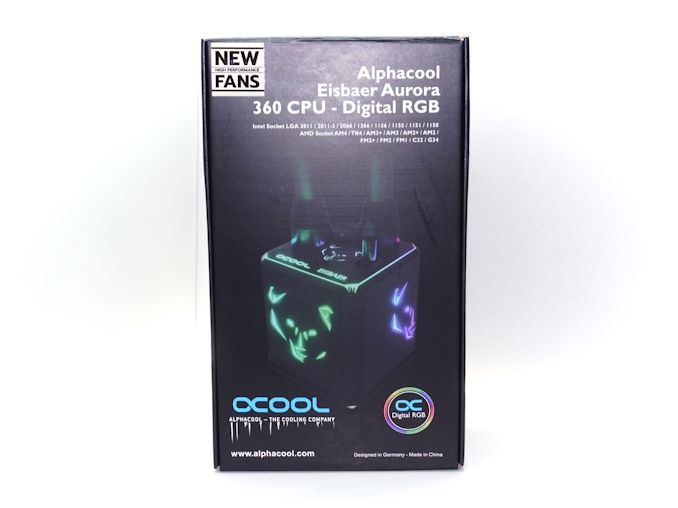
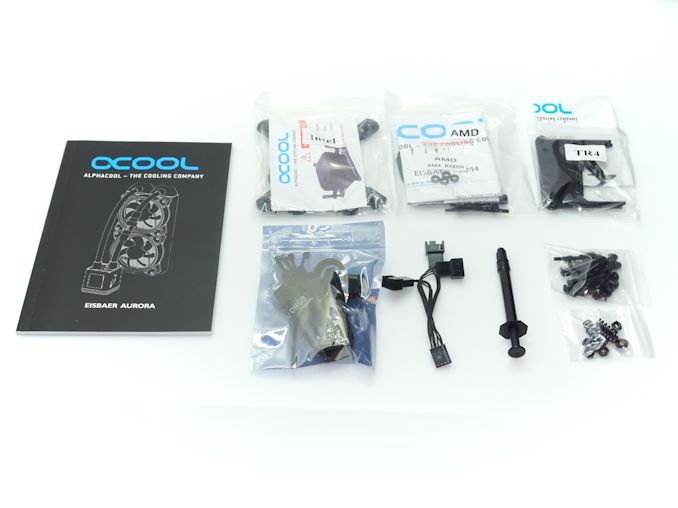

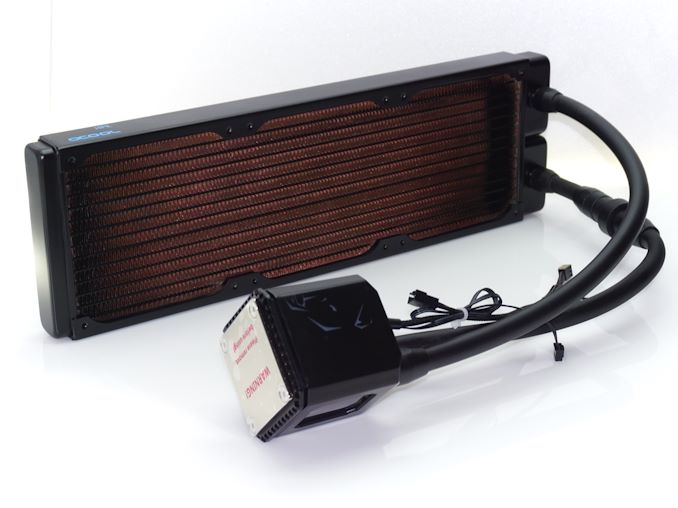
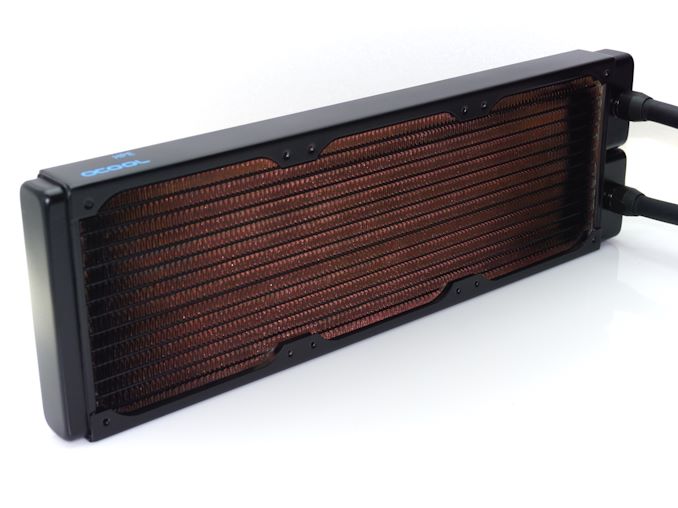
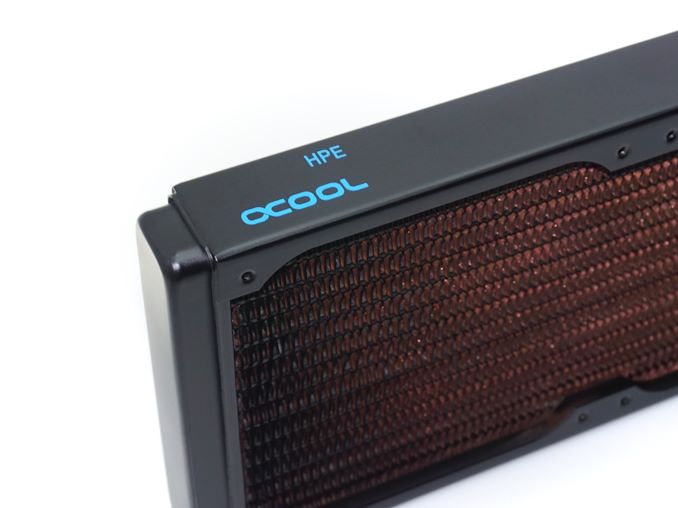
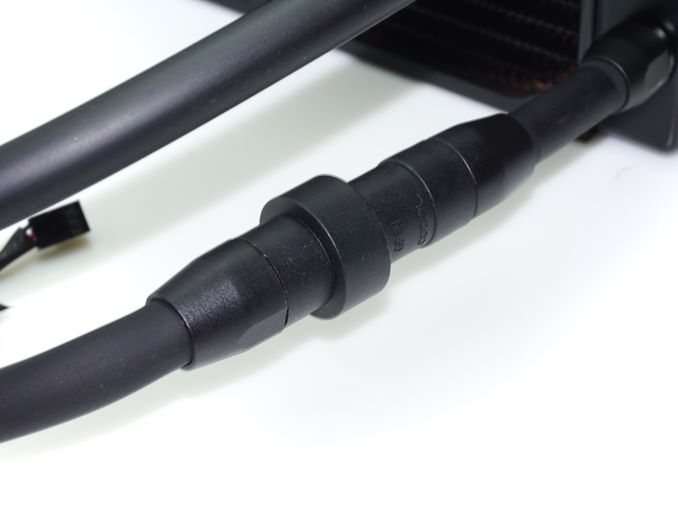
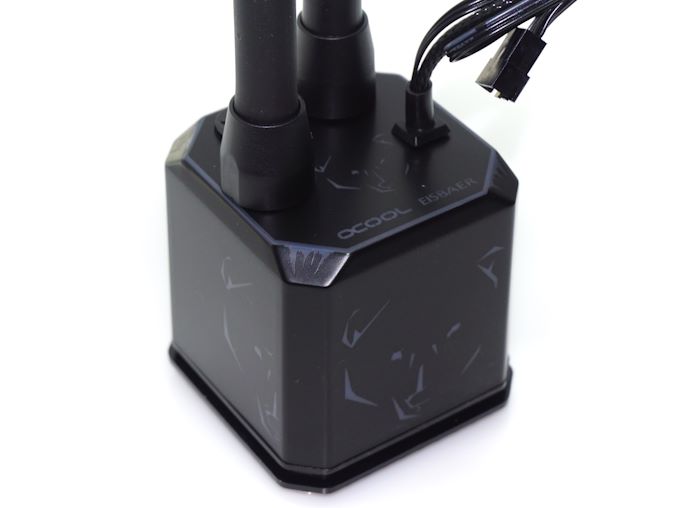
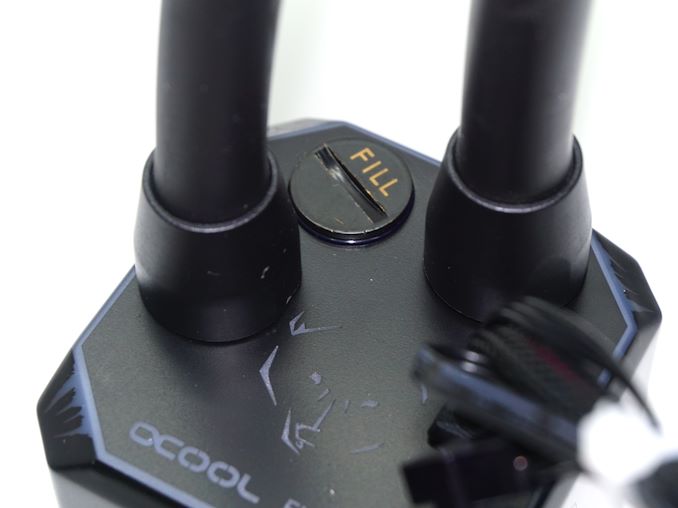
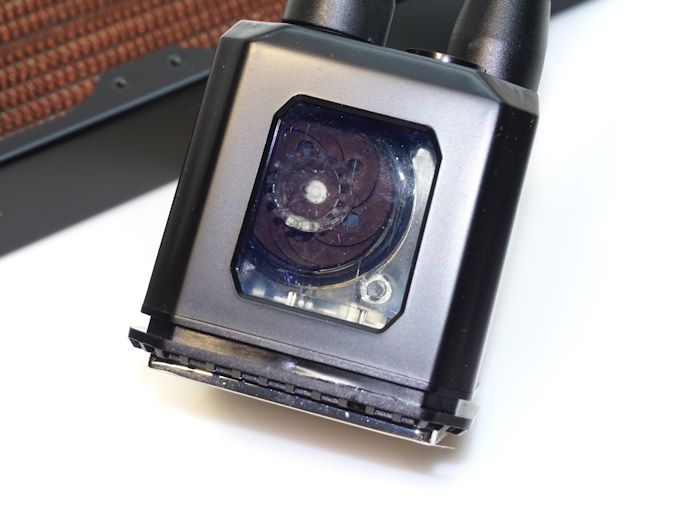
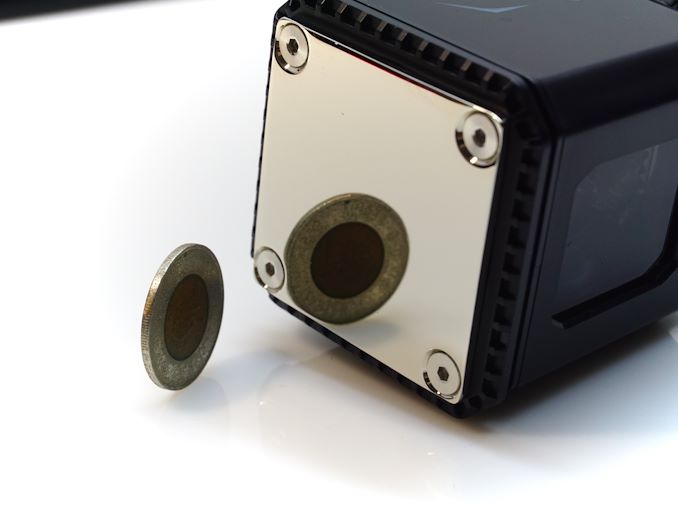

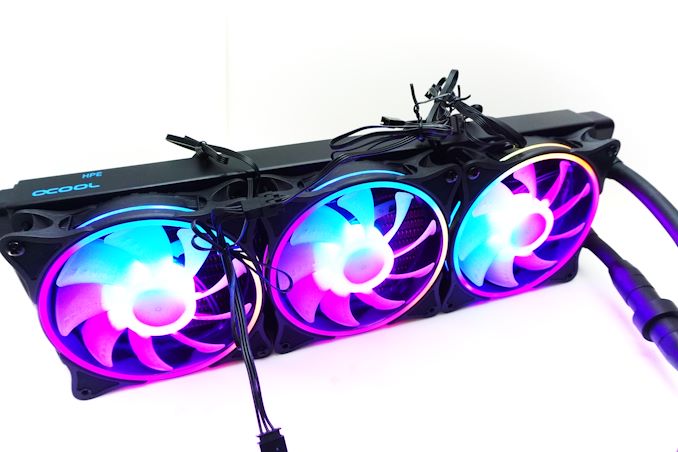








23 Comments
View All Comments
Juraj_SK - Thursday, August 11, 2022 - link
Why only 2 years warranty? Why aren't Germans be more confident with their product?There are competitors with 6 years warranty.
Or is liquid cooling something that needs to replaced regularly? (the tradeoff for the piece of silence :))
dysnomia - Thursday, August 11, 2022 - link
Aurora pump is very low quality, mine died exactly after one year.https://www.youtube.com/watch?v=SNKk2QInf_g
meacupla - Thursday, August 11, 2022 - link
If I had to guess, the warranty is shorter because the user is allowed more control over the coolant loop. If extra parts are added, that adds more complexity to the loop, and more room for user error.Things like: insufficient water causing the pump to run dry, adding in water that is not sterile, adding in water with too much mineral content, galvanic corrosion from mixing copper and aluminum parts, etc.
Yes, the liquid should be replaced, or topped off, every so often. Even in CLCs, the water does eventually permeate through the tubes, and results in more air being introduced into the loop. More air means the pump has a chance of running dry, and generally more noise generated.
Gamer's Nexus did a whole video on proper CLC configuration to minimize premature failure of the pump, and it is worth a watch.
Bedub1 - Thursday, August 11, 2022 - link
It would be great to see this system retested with fans that are optimized for high static pressure. Will it still perform as well? Will it be quieter?Makaveli - Thursday, August 11, 2022 - link
Thanks for the review.I'm currently on a Gen 1 Corsair H150i which is very quiet. This cooler has had my eye for abit since I like that you can add on to it. So I was thinking going with
Alphacool Eisbaer Aurora 360 CPU - Digital RGB + Alphacool Eiswolf 2 AIO - 360mm Radeon RX
However I'm considering upgrading my 6800XT to something from RDNA 3 this christmas so will hold out to see if they make an RDNA3 compatible AIO then bite the bullet.
dysnomia - Thursday, August 11, 2022 - link
They have great radiators and not bad fans. That is about all.thestryker - Friday, August 12, 2022 - link
I'm always happy to see cooler reviews pop up here because Anandtech still has my favorite methodology and is computer hardware agnostic.This seems like a good upgrade from the prior though I do wish they'd opted for static pressure fans. I do also find the 2 year warranty period to be on the short side since the vast majority of AIOs have increased warranty period in the last few years. I'm assuming it is due to the custom nature as most custom loop components still are at 2 year, but it's still the lowest warranty in its price/perf range by a lot.
With PCIe 5.0 M.2 SSDs on the way maybe they'll be making a block for those which would easily slot into this and wouldn't have much impact on loop performance.
PeachNCream - Saturday, August 13, 2022 - link
It really makes very little difference in day to day use after a certain point in the CPU performance curve and that point is a relatively low bar if we're being realistic with ourselves (typing this post, for example, from the keyboard of Dell Inspiron 1545 Core 2 Duo laptop running Linux and it's perfectly adequate even 12+ years after it rolled off the assembly line) so cooling solutions like this that are intended to wring a few percent in performance out of an edge case processor which land at high cost are bling toys sold to idiots intent on prodigiously throwing away electricity and generating more waste as they needlessly and mindlessly chase upgrades that external influences have imparted in them as important in seeking out some sort of meaning for themselves. The saddest part is that they're so incapable of self-awareness that they'll always have these simplistic, plant-like responses to being good little consumers of unnecessary products, capabilities, and services.Makaveli - Saturday, August 13, 2022 - link
Wow dude!philehidiot - Monday, August 15, 2022 - link
Because everyone has exactly your needs and you know what everyone should be using. Thank you for sharing your insight, oh benevolent master.The small market for this kind of kit is reflected in the high price compared to competitors. Some of us do genuinely have a use for this kind of thing.
I also run a 12 year old laptop which does the day to day stuff just fine. But I also routinely hit up against the limits of my main PC. Coolers like this might just extract a few extra percent. But they also keep things quiet whilst recording audio and mine has been through several CPUs.
If you don't see a need for it, that's just fine. Those of us who have systems running at full pelt for days on end do actually appreciate an extra few percent when that few percent is time which is also money.
So neeeeeer, mr small willy. Bow before my humongous epeen.